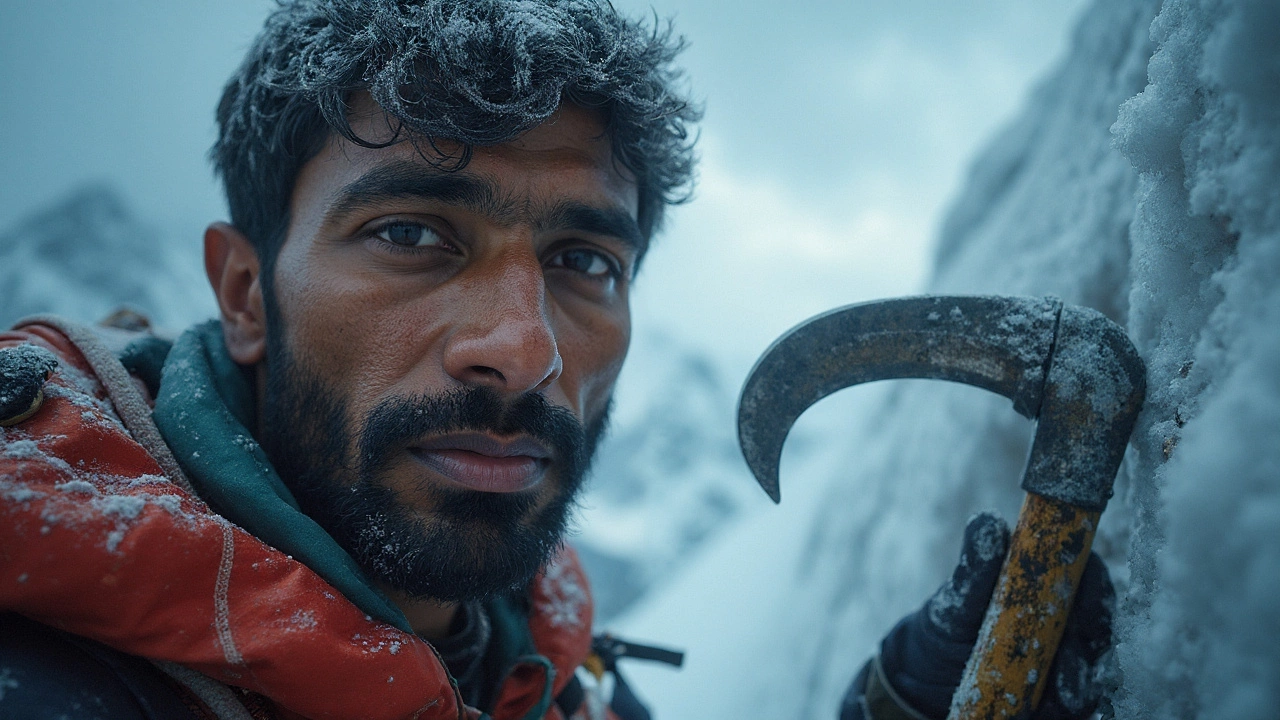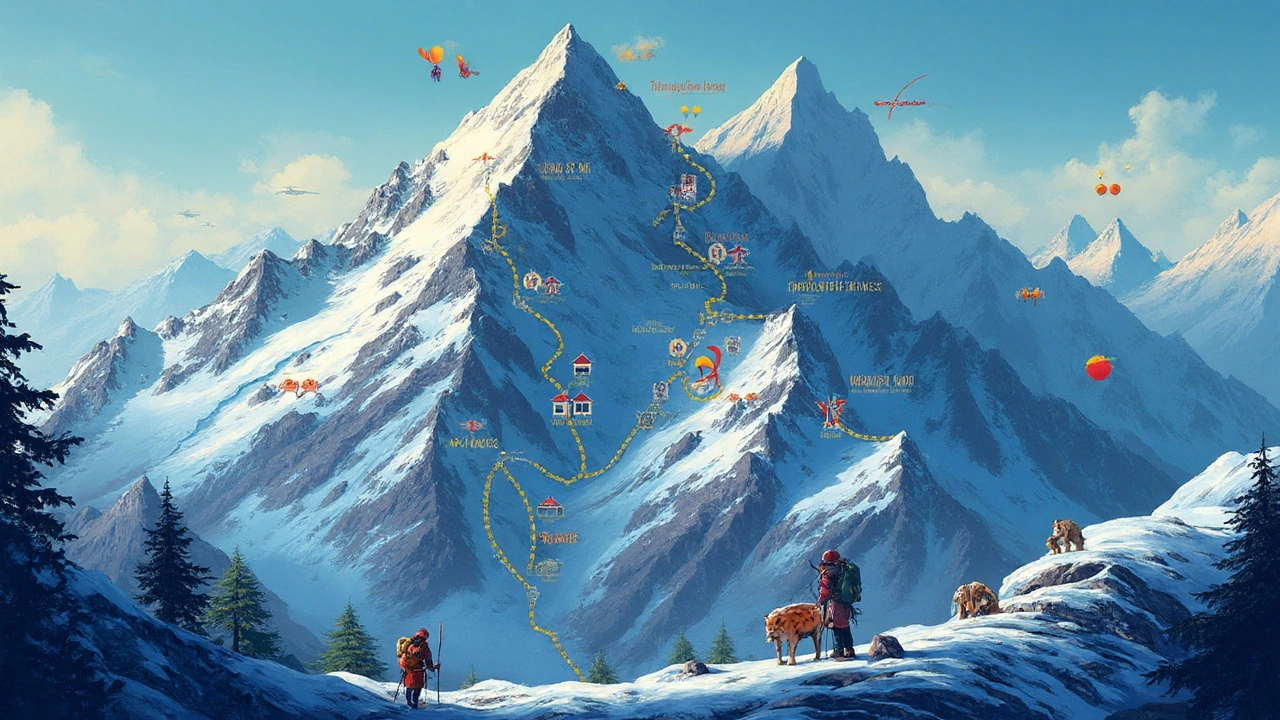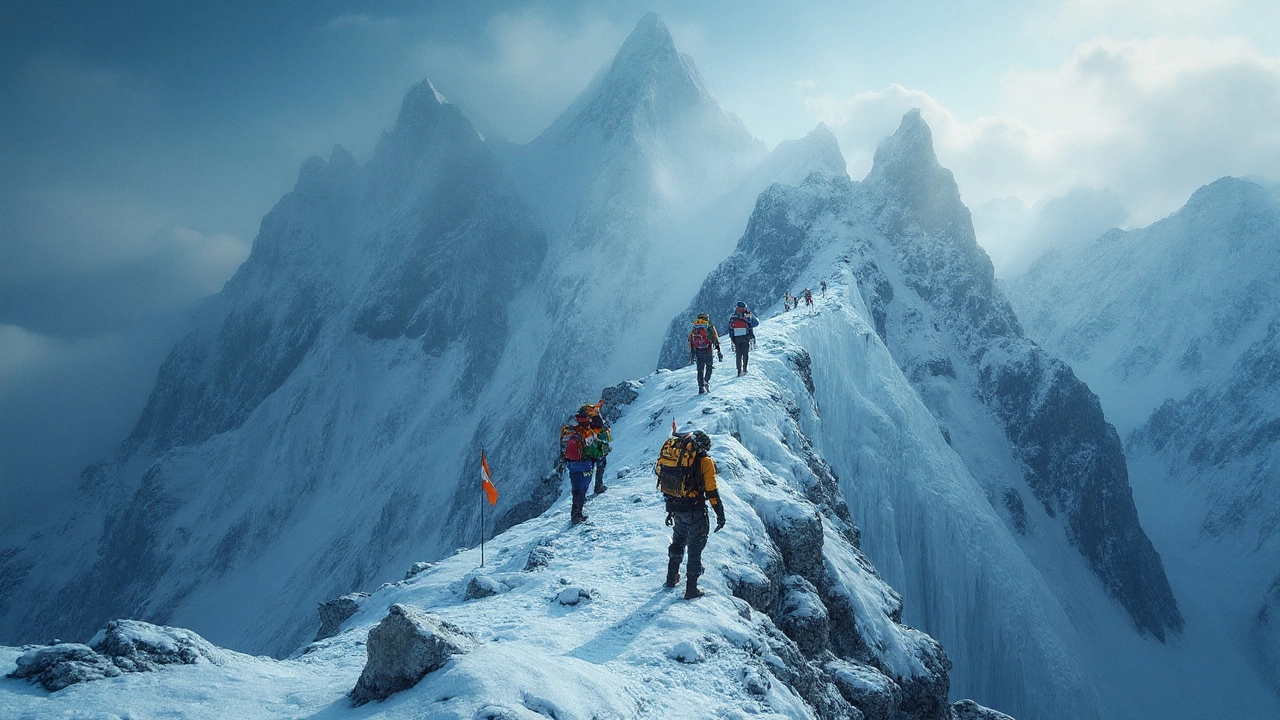One look at the jagged spine of the Indian Himalayas and you’ll understand why so many climbers lose sleep—there’s a magnetism, a dare, and a real sense of danger. Folks always throw out Mount Everest, but the real monsters are hiding in plain sight, and some of the deadliest, toughest climbs on Earth are right in India. If you Google about, you’ll see K2 is just over the border in Pakistan, but India’s own peaks have bodies, wild legends, and rescue stories that’ll make you think twice. Some years back, I flipped through a mountaineering magazine while Linus poked at his cereal, and the cover just said: "Why Kanchenjunga Sends Everest Climbers Home Crying." That pretty much planted the seed for this story.
The Hardest Peak in India: Kanchenjunga’s Relentless Reputation
Climbers whisper about Kanchenjunga like it’s some sort of boogeyman. It’s the third highest mountain in the world, sitting pretty at 8,586 meters near the Sikkim-Nepal border. Sure, Everest gets all the Instagram drama, but the climb to Kanchenjunga’s summit is less traveled and so much deadlier. More remote, more unpredictable weather, long stretches where help just isn’t coming. This mountain’s not forgiving or friendly. Since the first ascent in 1955 by a British team (who actually stopped short as a tribute to local beliefs), nearly every year brings more evidence of its danger: a fatality rate that swings between 20% and 25% depending on the season. That’s not a typo—one in four climbers, in bad years, doesn’t come back down. For comparison, Everest is closer to 3% these days. That stat alone makes Kanchenjunga the hardest peak to climb in India (and arguably anywhere).
What makes it so tough? First, the technical route: both the north and south ascents are laced with gigantic ice walls, avalanche-prone slopes, and crevasses that can swallow a bus. Weather never plays fair here—sudden whiteouts, fierce winds that rip tents apart, and a real cold that seeps into bones and battery packs. Even satellite phones are unreliable. Besides, you need serious permission from the Indian government just to set foot on the mountain—very few teams get that green light, and rescue ops are basically a no-go. In 2019, eight climbers went missing in a single sweep, and their bodies were stuck up there for weeks. That kind of isolation changes how you think about risk.
Climbers say that what really haunts them isn’t just the terrain, but the mental fight—days of slogging in snow up to your waist, the endless cold, and never knowing if a cornice will hold or collapse. There’s no showboating on Kanchenjunga, and even the bravest climbers make offerings to the mountain before trying their luck. Sherpas have a tradition: they stop just short of the true summit out of respect for the sacred ground, and every team follows suit to this day. So, you don’t just need to be fit and experienced—you have to play by the mountain’s rules, or pay dearly.
| Mountain Name | Height (meters) | Fatality Rate (%) | First Successful Ascent |
|---|---|---|---|
| Kanchenjunga | 8,586 | 20-25 | 1955 |
| Nanda Devi | 7,816 | 15 | 1936 |
| Kedarnath Dome | 6,831 | 5 | 1947 |
| Kamet | 7,756 | 7 | 1931 |

Other Notorious Indian Peaks: Nanda Devi, K2 (Within Range), and More
Kanchenjunga may rule the roost, but India isn’t short on other brutal climbs. Nanda Devi, for instance, is wrapped in local myth and off-limits to climbers most years because it’s both sacred and protected as a biosphere reserve. Back in 1936, a British-American team bagged the summit after seven weeks, leaving behind stories of frostbite and near-starvation. What’s wild is, even after the ban in the 1980s (after a CIA spy device was lost on the peak), there’s always hushed talk of secret climbs that ended badly. The fatality rate hovers above 15%, mostly due to the wicked weather and zero rescue support—get stuck, and you’re on your own.
K2 gets name-dropped a lot, and while it’s technically in Pakistan, some satellite peaks nudge the Indian border. But India’s Karakoram range has monsters like Saltoro Kangri and Sia Kangri—rarely climbed, much less talked about outside serious mountaineering circles. These peaks see almost no traffic: you’re not just fighting altitude and elements, you’re battling red tape, military blockades, and no Google-able maps. It’s wild country out there, with glaciers that look straight out of a sci-fi movie. Even experienced Sherpas get jumpy here. Think of it as adventure dialed up to eleven.
Don’t overlook the likes of Kamet and Kedarnath Dome. Kamet, at 7,756 meters, was the highest summit climbed before Everest, and getting there today still takes a miracle: days of boulder fields, creaking glaciers, and sudden rockfalls. Kedarnath Dome looks tame, but just last season, two teams had to be pulled off because of savage storms. It’s not about the height, but the unpredictability—these are all commitment peaks. You might spend a week just getting to basecamp, wading through icefalls, dealing with portable oxygen tanks that freeze solid, and hoping you packed enough batteries for your headlamp. It’s nothing like weekend treks in Himachal—it’s real, raw survival.
And if you ask locals in Uttarakhand or Sikkim about mysterious disappearances, you’ll hear more than one story of climbers never seen again. The mountains out here hide their secrets well. It’s not about Instagram likes but a grit test few can pass.

What Makes These Peaks So Difficult: Factors, Dangers, and Survival Tips
There’s a recipe for a death trap: add high altitude, minus-40 temperatures, bottomless crevasses, and storms so severe you can’t stand upright. Kanchenjunga and company have all that in spades—and toss in rotten luck with sudden avalanches. The main problem? The remoteness. Unlike Everest, which has check-in points, helicopter rescues, and a literal traffic jam during the season, climbs in India are do-it-yourself affairs. Once you’re above base camp, you won’t see another party for days. Run out of gas or food, or lose your tent, and you’d better have survival skills, not just a strong Instagram game.
- Training is everything: No shortcuts—climbers spend years prepping on tough European routes before even applying to climb. You’ll need ice-climbing, crevasse rescue, and survival med training.
- Acclimatization is brutal:
- The air at 8,000+ meters has about one-third the oxygen of sea level.
- Climbers have to go up and down the mountain multiple times just to teach their bodies how to function, or risk high-altitude pulmonary or cerebral edema (that’s blood in your lungs or brain, by the way).
- Gear failures are serious:
- Sub-zero temperatures make plastic crack and electronics freeze within hours. Satellite phones, oxygen tanks, even your water bottle—all need serious prepping.
- Route navigation isn’t marked:
- Unlike in the Alps, expect long bits where you’re navigating by memory, map, or luck. One wrong step and you punch through a snow bridge into a crevasse.
- Weather is a killer:
- Even weather forecasts are dicey. You could get stuck in high winds for days, pinned to the side of the mountain with no way up or down until the storm blows out.
- Permits and politics:
- Especially in places near the China or Pakistan borders—permits can get yanked last minute for security reasons. You could train for years and never get the chance to climb.
- You need serious logistics:
- Porters aren’t always available. Some teams have to haul gear themselves for days.
If you ever think about attempting one of these climbs, respect is the name of the game. Know your gear, double-check your avalanche transceiver, set turnaround times, and never chase the summit if the mountain throws you a warning. I remember, one of Linus’s favorite bedtime stories involved a climber who turned back just before the summit—he survived, had a cold pizza in base camp while a storm raged that nearly wiped out two other teams. Chasing glory is nice, but living to tell the story is the real win.
That’s why Kanchenjunga stands as India’s toughest, deadliest climb—a challenge for those who crave more than just a summit selfie. It’s a test of skill, guts, and a little bit of luck. And if you make it, you’ll join a pretty exclusive club—one that knows the Himalayas always hold the last word.
